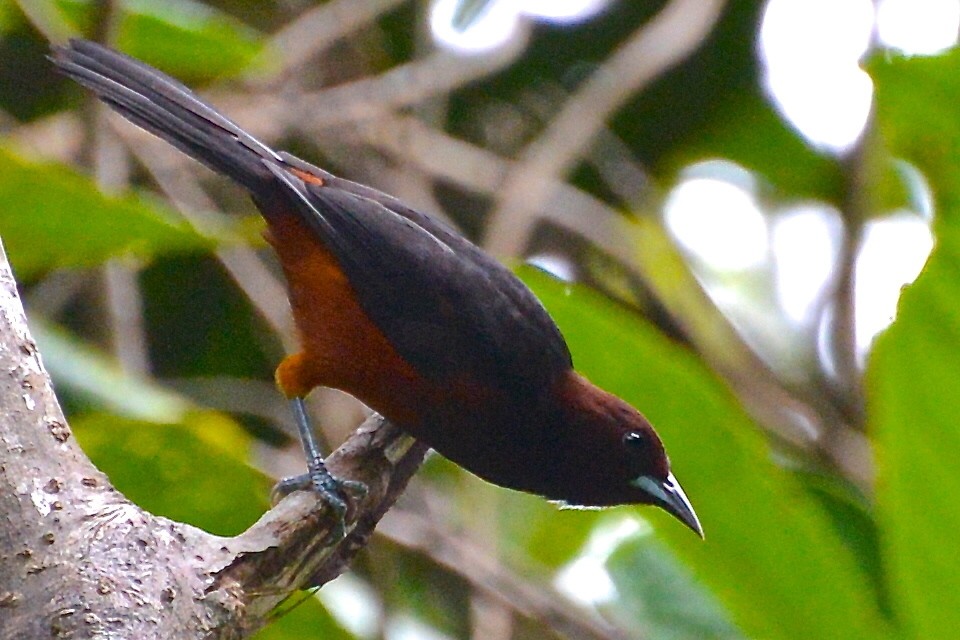Martinique Oriole
A species of New world orioles Scientific name : Icterus bonana Genus : New world orioles
Martinique Oriole, A species of New world orioles
Botanical name: Icterus bonana
Genus: New world orioles
Content
Description General Info
 Photo By jvp0208 , used under CC-BY-NC-4.0 /Cropped and compressed from original
Photo By jvp0208 , used under CC-BY-NC-4.0 /Cropped and compressed from original Description
Compared to the other orioles of the Lesser Antilles, this oriole spots the most unusual plumage coloration. The Martinique Oriole has mainly black plumage with a reddish-orange belly,and grows to 18–21 cm. The males of this species are slightly brighter than the females. It makes harsh scolding calls, and whistles. Whether females sing or not is currently being researched. It eats fruit from the canopy, berries and various insects, foraging alone, in pairs or with a group of family members. Breeding is generally observed between February–July, however breeding has been recorded in December. It is closely related to several other orioles found in the Caribbean. 
Size
21 cm
Nest Placement
Tree
Feeding Habits
Martinique Oriole predominantly consumes insects, arthropods, fruits, and nectar. It forages for various prey such as caterpillars and ants, including stick-insects, while also feeding on wild and cultivated fruits like the Malabar almond. This oriole species exhibits particular preferences for certain fruits and insects.
Habitat
Martinique Oriole typically inhabits mangroves and dry forests that grow on limestone soils, as well as humid forests. It can also be found in cultivated areas such as plantations and sometimes adapts to urban environments in towns. The species shows a preference for the dry forest regions and mangrove ecosystems, thriving from sea level up to elevations of approximately 700 meters. These habitats are characteristically found within broader tropical and subtropical geographic regions.
Dite type
Frugivorous
General Info
Feeding Habits
Bird food type

Fruit
Distribution Area
Martinique orioles are found in Martinique, French West Indies. They appear in a density of 2.4 birds/ha in central Martinique. Originally present in many habitat-types below 700 m, the Martinique Oriole is now mainly found in mangroves and dry forests. The Martinique Oriole generally likes to distance itself from heavily urbanized communities. It places its nest on the underside of wide leaves such as that of a banana plant, palm or Heliconia. Once the nests have been formed, they typically lay two, or sometimes three eggs. Its preferred habitat is in moist highland habitats; however, it could also be found in lowland dry forest habitats. Birds of this species do not form flocks, yet still communicate with each other via whistling, uttering harsh, scolding calls and singing a soft, warbling song. It is a territorial bird, however the territory they control is relatively small, as they have not been seen to feed more than 100 meters from their nest. Much more research is needed on this species. 
Species Status
Deforestation has led to recent establishment of the Shiny Cowbird (Molothrus bonariensis) within the Martinique Oriole habitat. The Shiny Cowbird parasites 75% of the oriole nests each year. Another possible threat is from the increase in native Carib Grackles (Quiscalus lugubris), the oriole's main predator, which engage in nest-predation of the Martinique Oriole. The Martinique oriole is protected by domestic legislation. According to the IUCN, the Martinique Oriole is listed as vulnerable and more research is needed on the threats and population status of the bird for conservative purposes. 